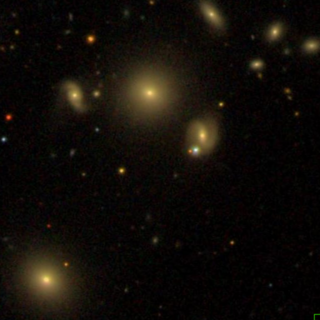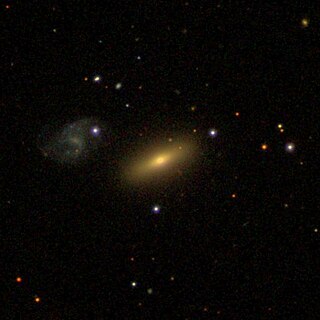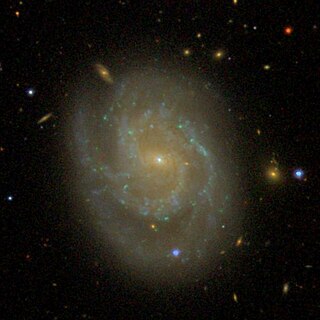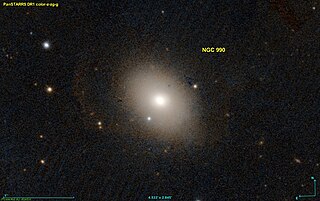
NGC 5614 is an unbarred spiral galaxy in the constellation Boötes. It is the primary member of the Arp 178 triplet of interacting galaxies with NGC 5613 and NGC 5615.

NGC 3554 is an elliptical galaxy in the constellation Ursa Major. It was discovered in December 1827 by John Herschel.

NGC 42 is a lenticular galaxy in the Pegasus constellation. It was discovered on October 30, 1864, by the German astronomer Albert Marth. It may be gravitationally interacting with the nearby NGC 41.

NGC 3268 is an elliptical galaxy in the constellation Antlia. It is a member of the Antlia Cluster, which lies about 40.7 megaparsecs away. It was discovered on April 18, 1835 by the astronomer John Herschel.

NGC 3258 is an elliptical galaxy in the constellation Antlia. It is a member of the Antlia Cluster, which lies about 40.7 megaparsecs away. It was discovered on May 2, 1834 by John Herschel.

NGC 3281 is a large unbarred spiral galaxy in the southern constellation of Antlia, located at a distance of 144.7 megalight-years from the Milky Way. The galaxy is inclined by an angle of 64° to the line-of-sight from the Earth, with the major axis aligned with a position angle of 137°. It is a luminous infrared galaxy and a type II Seyfert galaxy. NGC 3281 is a member of the Antlia Cluster, which belongs to the Hydra–Centaurus Supercluster.

NGC 1728 is a spiral galaxy in the constellation Eridanus. The galaxy is listed in the New General Catalogue. It was discovered on November 10, 1885 by the astronomer Edward Emerson Barnard.

NGC 479 is a spiral galaxy in the constellation Pisces. It was discovered by German astronomer Albert Marth on October 27, 1864. It is about 240 million light-years away from Earth.

NGC 5201 is a spiral galaxy located in the constellation Ursa Major. It was discovered on April 14, 1789 by German-born British astronomer William Herschel. It is about 384 million light years away.

NGC 1326 is a lenticular galaxy in the constellation Fornax, 63 million light-years away. It was discovered by English astronomer John Herschel on 29 November 1837. It is a member of the Fornax Cluster, an NGC 1316 subgroup and has a diameter of 70 000 light-years.

NGC 950 is a barred spiral galaxy in the constellation Cetus. It is approximately 205 million light-years away from the Solar System and has a diameter of about 85,000 light-years. The object was discovered in 1886 by American astronomer and mathematician Ormond Stone.

NGC 3686 is a spiral galaxy that forms with three other spiral galaxies, NGCs 3681, 3684, and 3691, a quartet of galaxies in the Leo constellation. It was discovered on 14 March 1784 by William Herschel. It is a member of the NGC 3607 Group of galaxies, which is a member of the Leo II Groups, a series of galaxies and galaxy clusters strung out from the right edge of the Virgo Supercluster.

NGC 990 is an elliptical galaxy located in the constellation Aries about 153 million light-years from the Milky Way. It was discovered by the German - British astronomer William Herschel in 1786.

NGC 906 is a barred spiral galaxy in the constellation Andromeda in the northern sky. It is estimated to be 215 million light years from the Milky Way and has a diameter of approximately 110,000 ly. NGC 906 was discovered on October 30, 1878 by astronomer Édouard Stephan.

NGC 996 is an elliptical galaxy of the Hubble type E0 in the constellation Andromeda. It is estimated to be 210 million light years from the Milky Way and has a diameter of approximately 75,000 ly. The supernova SN 1996bq occurred in this galaxy. NGC 996 was discovered on December 7, 1871 by astronomer Édouard Stephan.

NGC 531 is a barred spiral galaxy in the constellation Andromeda with a visual magnitude of 10.51. It is a distance of 65.7 Mpc from the Sun. It is a member of the Hickson Compact Group HCG 10, and is interacting with the other members of the group.

NGC 766 is an elliptical galaxy located in the Pisces constellation about 362 million light years from the Milky Way. It was discovered by British astronomer John Herschel in 1828.

NGC 623 is a large elliptical galaxy located in the Sculptor constellation at a distance of about 400 million light-years away from the Milky Way. It was discovered by British astronomer John Herschel in 1837.

NGC 861 is a spiral galaxy in the constellation Triangulum. It is estimated to be 360 million light-years from the Milky Way and has a diameter of approximately 165,000 light-years. The object was discovered on September 18, 1865 by Heinrich d'Arrest.

NGC 677 is an elliptical galaxy located in the constellation Aries. It was discovered on September 25, 1886, by the astronomer Lewis A. Swift. It is located about 200 million light-years from Earth at the center of a rich galaxy cluster. It has a LINER nucleus.




















